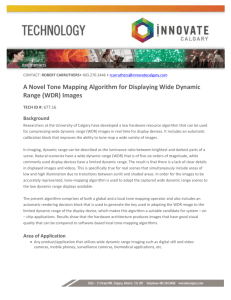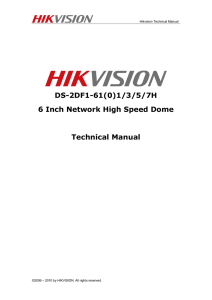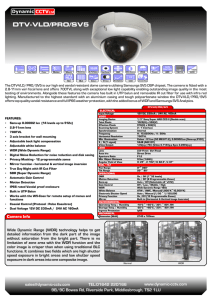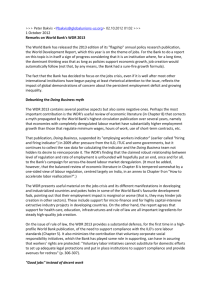Wide Dynamic Range
advertisement
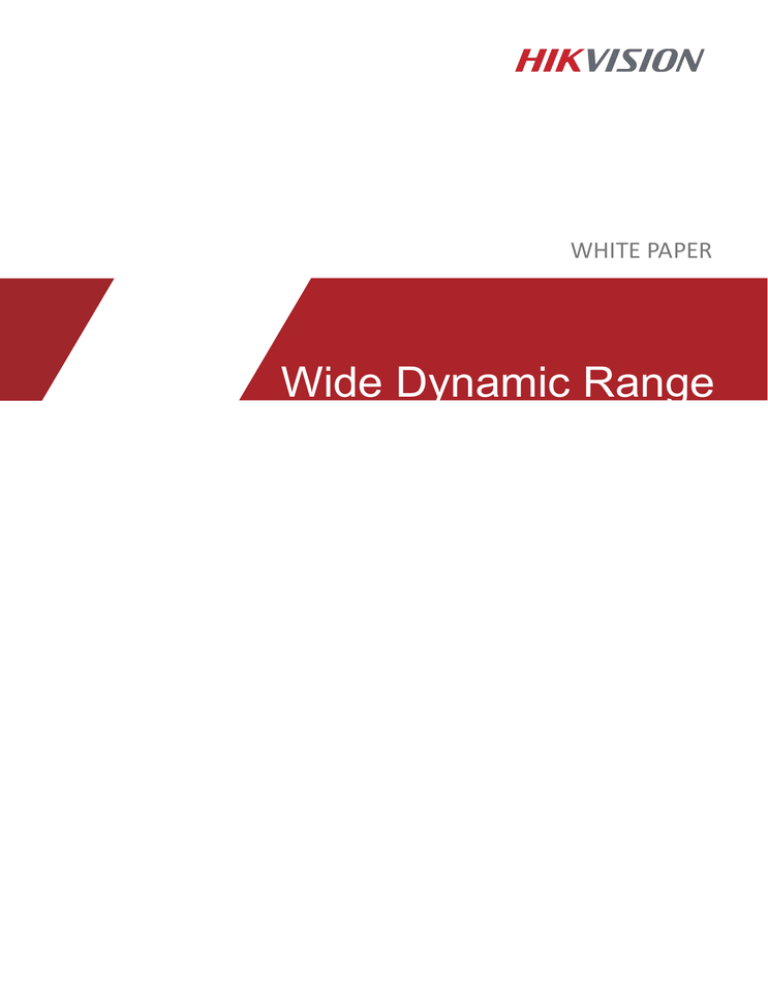
WHITE PAPER Wide Dynamic Range Overview In many practical surveillance applications, the intensity of illumination with a scene can vary excessively. Images taken by standard cameras always seem to have an overexposed foreground or too dark a background due to the limitation of a camera sensors’ sensitivity. Over the course of a day, the situation can change with different areas of the scene being over or underexposed. What is required in this situation is a Wide Dynamic Range (WDR) camera. Dynamic Range The imaging luminance of a monitored object is mainly dependant on the intensity of illumination radiating or reflecting from the object that is captured by the sensor. The unit of measure for illumination intensity is the lux unit. For a non-light-source object being monitored, the reflection intensity is also affected by its surrounding illumination, reflecting ratio and other factors. In a real situation, the illumination of different areas may differ greatly even in the same surveillance scene. For example, on a bright sunny day, the surrounding illumination in the outdoor area can reach 100,000 lux, while the illumination at the desk indoors is approximately 1000 lux while the shadowed area below the desk is as low as 10 lux. Assuming that all those areas have similar reflection capability, the reflection ratio of the indoor shadowed area to the indoor normal lighting area to the outdoor area is 1: 100: 10,000. If we want to preserve at least 5 grey scales in the dark area so as to distinguish between objects with different reflectivity, the capability required to acquire the image information of the three parts mentioned above is 10,000 / 0.2 = 50000 times, corresponding to a dynamic range of 16bit (94db); however, most common image sensors can’t reach this value. The dynamic range of the current common CMOS sensor is around 12 bits, or72db. When a CMOS sensor is used in such a scene, the image details either in the bright or dark areas will get lost. Figure 1. Image is overexposed or underexposed in wide dynamic range scene WDR Imaging Various approaches have been tried to extend the dynamic range of the image sensor, and currently the Multiple Exposure and the Per-pixel Exposure are generally used to control the exposure intensity. The idea of Multiple Exposure is to get two or more exposures with different time durations on one scene and to accumulate enough data to create a single image. On the other hand, the Per-pixel Exposure can get the same imaging result by setting different sensitivity levels for the neighboring pixels on the sensor. In a dynamic range scene of 94db as mentioned above, the multiple exposure technique uses the 12bit (72db) image sensor to make a first exposure with the exposure time of 1/50 s, which enables the camera sensor to acquire enough details in the darker area yet the image in the brighter area is overexposed; then the sensor makes a second exposure of 1/800 s to weaken the exposure intensity on the brighter area to 1/16 while the image in the darker area is underexposed. The resulting image contains the subsequent image superimposed over the original, achieving the a dynamic range of 16bit (96db) which is 16 times that of 12bit (72db) image with the single exposure. The Per-pixel Exposure aims to reach the same resulting image by designing the sensitivity of the high sensitive pixels to 16 times of that of the low sensitive pixels. full range short exposure capture range long exposure ail ht rig short exposure t los det B Bri ght tail Dark de det ail cap tur ed ed captur long exposure capture range Dark t l los detai Figure 2. Extend dynamic range by multiple exposure However, although the dynamic range of the imaging sensitivity can be effectively increased by multiple exposure and per-pixel exposure, they are not perfect. The multiple exposure method will cause some ghosting at the edges of the moving object due to tiny differences existing in each exposure, and the perpixel exposure may directly reduce the resolution of the image. Tone Mapping As display devices, such as LCD monitors, computers and projectors, all have a limited dynamic range that is inadequate to reproduce the full range of light intensities present in natural scenes, tone mapping can be applied to represent the whole dynamic range while retaining realistic color and contrast. Tone mapping can be mainly divided into two main types: global and local tone mapping. The method of global tone mapping is similar to the Gamma curve in photography since every pixel in the image is mapped in the same way by referring to a non-linear look-up table. When the rate of curve decreases in the Gamma table which is frequently used for dynamic mapping, the output range will be reduced if the input data is large. Figure 3. Global Tone Mapping The technique of global tone mapping is simple and fast since every pixel in the image with the same brightness will be mapped in the same way, however, it can cause insufficient contrast or a loss of contrast in brighter areas, etc. The local tone mapping can change the brightness in each pixel according to features extracted from the surrounding parameters of the image. Pixels located in different parts in the image are mapped to different results even though they have the same brightness, and such method can provide sharp contrast and more details in the resulting image. Digital Wide Dynamic Range According to the above background information, the wide dynamic range technique must contain at least two stages: wide dynamic range imaging and tone mapping. For cameras, the real application of wide dynamic range imaging must be supported by the professional image sensor. Currently another technique, which is generally referred to as digital wide dynamic range (digital WDR), is adopted using local tone mapping instead of wide dynamic imaging to provide the image enhancement. The digital WDR function cannot really extend the dynamic range of the camera but simply enhances the details in the darker or brighter areas in the image by local tone mapping and optimizing visible contrast. Hikvision WDR Technique Based on the principles of local tone mapping, the Hikvision WDR Technique mainly features in the Luminance-adaptive Tone Mapping (LATM) and the Space-variant Contrast Enhancement (SVCE). The LATM technique is an approach of global tone mapping which can re-map the pixel brightness according to the brightness and contrast of the surrounding scene, aiming to enhance the brightness in darker areas and simultaneously restrain the overexposure in brighter areas. With the LATM-mapped curve, the original WDR values can be re-mapped to compress the dynamic range, and the darker areas in the image can be effectively brightened by adjusting the greyscale distribution. Figure 4. LATM Mapping By simulating the local characteristics of the human vision system, the SVCE technique is able to enhance the local contrast of the image and reproduce the image details in the dynamic range compression (DRC) function, making image details more realistic and transparent with better contrast. Figure 5. Simulation Effect of Hikvision WDR Technique Hikvision’ WDR technology makes full use of the full dynamic range of sensor itself and it is compatible with the complete wide range of sensor output data bits, from 12 to 20-bit. When the sensor outputs high bit data, the WDR algorithm has a better DRC effect and it can remap the high bit data to standard 12-bit data, and output vivid wide dynamic images. Because a human’s vision system is more sensitive to dark areas, when the sensor outputs standard bit wide data, WDR simulates the characteristics of a human eye and takes full advantage of the dynamic range of the data itself to ensure optimal wide dynamic effect. Figure 6. Simulation Effect of Hikvision WDR Technique Hikvision’ WDR technology is applied automatically, just as the human eye can compensate for ever changing scenes. With other WDR cameras, the WDR feature, which is either on or off, often produces un-natural colors and other issues especially at night. With Hikvision’ automatic WDR, these issues are avoided, with the resulting dynamic range, just the way a human sees it. About US Hikvision is the world’s largest supplier of video surveillance products and solutions. The company specializes in video surveillance technology, as well as designing and manufacturing a full-line of innovative CCTV and video surveillance products. The product line ranges from cameras and DVRs to video management software. Since its inception in 2001, Hikvision has quickly achieved a leading worldwide market position in the security industry. Hikvision possess the world’s largest R&D team and state-of-art manufacturing facilities; both allow Hikvision’s customers the benefit of world-class products that are designed with cutting-edge technology. As further commitment to its customers, Hikvision annually reinvests 7% of its revenue into R&D for continued product innovation and improvement. Hikvision operates 31 domestic branches in China and 12 overseas regional branch offices, in conjunction with over 30,000 partners all over the world to achieve a truly global presence. Hikvision is now publicly listed on the Shenzhen Stock Exchange. For more information, please visit Hikvision’s website at www.hikvision.com. Hikvision HQ No.700 Dongliu Road, Binjiang District, Hangzhou 310052, China Tel: +86-571-8807-5998 Email: overseasbusiness@hikvision.com www.hikvision.com
